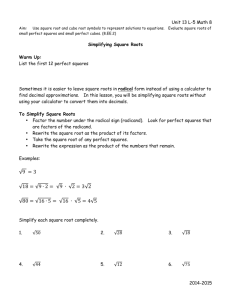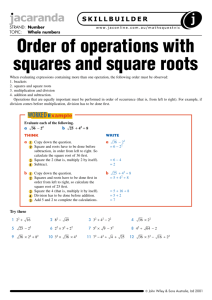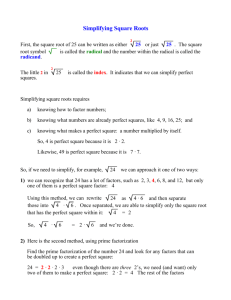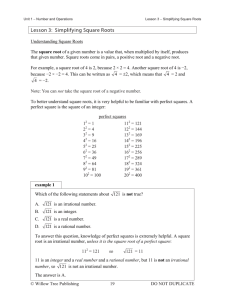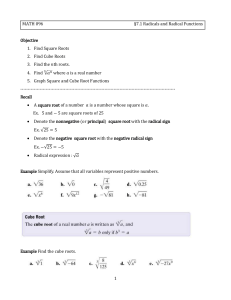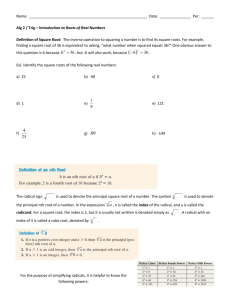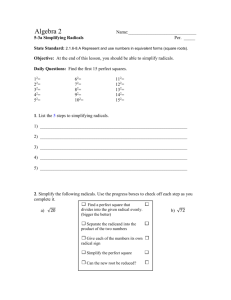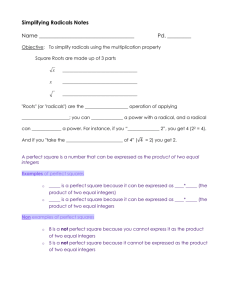Simplifying Square Roots
advertisement
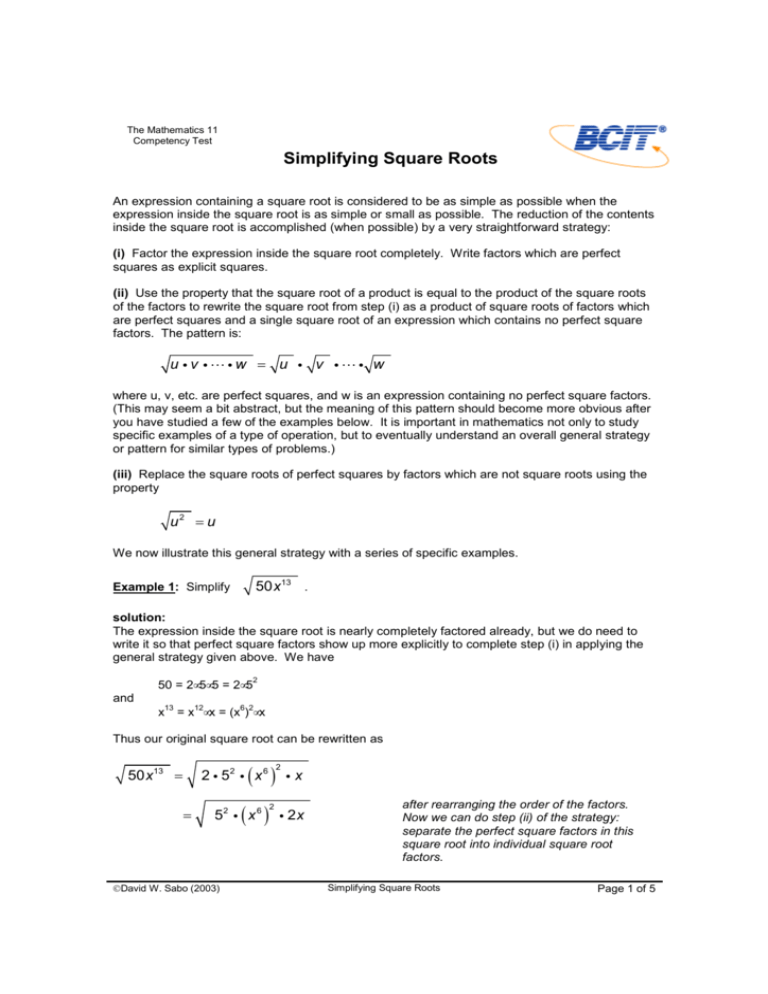
The Mathematics 11 Competency Test Simplifying Square Roots An expression containing a square root is considered to be as simple as possible when the expression inside the square root is as simple or small as possible. The reduction of the contents inside the square root is accomplished (when possible) by a very straightforward strategy: (i) Factor the expression inside the square root completely. Write factors which are perfect squares as explicit squares. (ii) Use the property that the square root of a product is equal to the product of the square roots of the factors to rewrite the square root from step (i) as a product of square roots of factors which are perfect squares and a single square root of an expression which contains no perfect square factors. The pattern is: u i v i⋯iw = u i v i⋯i w where u, v, etc. are perfect squares, and w is an expression containing no perfect square factors. (This may seem a bit abstract, but the meaning of this pattern should become more obvious after you have studied a few of the examples below. It is important in mathematics not only to study specific examples of a type of operation, but to eventually understand an overall general strategy or pattern for similar types of problems.) (iii) Replace the square roots of perfect squares by factors which are not square roots using the property u2 = u We now illustrate this general strategy with a series of specific examples. 50x13 . Example 1: Simplify solution: The expression inside the square root is nearly completely factored already, but we do need to write it so that perfect square factors show up more explicitly to complete step (i) in applying the general strategy given above. We have 50 = 2•5•5 = 2•5 2 and x 13 = x •x = (x ) •x 12 6 2 Thus our original square root can be rewritten as ( ) 50 x13 = 2 i 52 i x 6 = ( ) 52 i x 6 David W. Sabo (2003) 2 2 ix i 2x after rearranging the order of the factors. Now we can do step (ii) of the strategy: separate the perfect square factors in this square root into individual square root factors. Simplifying Square Roots Page 1 of 5 = 52 i = 5 i x6 i (x ) 6 2 now we can apply step (iii) of the strategy to the first two factors … i 2x 2x = 5 x 6 to get our final result. 2x Notice that the remaining square root factor in this final expression, 2x , contains no further perfect square factors, and so there is no way to reduce the expression inside this remaining square root any further. Thus, our final answer is: 50 x 13 = 5 x 6 2x Even though you can probably do the first step of this strategy – the factorization to show perfect square factors – without writing down a lot of intermediate steps, we suggest that you do write down enough of the details to reliably keep track of what you are doing. It is particularly important to ensure that the perfect squares that you identify are accurate, and the best way to do that is to show at least as much work as we did in the solution to Example 1 above. For powers of symbols, even powers are always perfect squares. Odd powers are a product of a perfect square and the first power of that symbol. 400y 7 . Example 2: Simplify solution: First, we factor the expression inside the square root to display all possible perfect square factors explicitly. Methods for ensuring a complete factorization of numbers into a product of prime factors have been covered elsewhere in these notes. 400 = 2•200 = 2•2•100 = 2•2•2•50 = 2•2•2•2•25 = 2•2•2•2•5•5 = 2 •5 = (2 ) •5 4 2 2 2 2 and y = y •y = (y ) •y 7 6 3 2 So, 400 y 7 = (2 ) 2 2 = i 52 i ( y 3 ) i y 2 (2 ) 2 2 52 i i ( ) ( ) = 22 ( 5 ) y 3 = 20y 3 (y ) 3 2 i y y y as the final answer. David W. Sabo (2003) Simplifying Square Roots Page 2 of 5 32ab3c 4 Example 3: Simplify . solution: Here 32 = 2 = (2 ) •2 5 2 2 and ab c = a•b •b•(c ) = b (c ) •ab 3 4 2 2 2 2 2 2 So (2 ) 2 2 32ab 3c 4 = = ( ) i 2 i b2 i c 2 (2 ) 2 2 2 b2 i i ( ) ( ) = 22 ( b ) c 2 i ab (c ) 2 2 i 2ab 2ab = 4bc 2 2ab . x2 + y 2 . Example 4: Simplify solution: There is a strong temptation here to simply take the square root term by term to get x2 + y 2 → x2 + y2 → x+y However, you should see immediately that the first step violates the previously stated properties of radicals and so is invalid. The only way we can simplify this expression is if we are able to first factor it into a product in which one or more factors are perfect squares. Here, the expression 2 2 x + y cannot be factored using any of the techniques available to us, and so no progress can be made as far as simplifying this square root. We are forced to conclude that the given expression is already in simplest radical form, and nothing can be done to reduce the expression inside the radical to a simpler algebraic form. Example 5: Simplify x 4 + 9x2 . solution: 4 2 There seems to be a lot of perfect squares here – in fact, x , 9, and x are all perfect squares. However, only perfect square factors of the entire expression in the radical are of any use to us David W. Sabo (2003) Simplifying Square Roots Page 3 of 5 here. Proceeding using the methods for factoring algebraic expressions that were covered in detail earlier in these notes, we get 4 2 2 2 x + 9x = x (x + 9) as the most complete factorization possible. Thus ( x )( x x 4 + 9x2 = 2 2 +9 ) (x ) (x = 2 (x =x 2 2 +9 ) + 9) Again, the expression left in the square root in this last line cannot be factored further at all, and so we cannot extract any further perfect square factors inside the square root to allow further simplification of the square root. Thus x 4 + 9x2 = x x2 + 9 must be the final answer here. x7 + x5 . Example 6: Simplify solution: The method to be used here has been well illustrated already, so you should use this example as a practice problem – try to solve it yourself before looking at the solution that follows. Since 7 5 5 2 x + x = x (x + 1) 4 2 = (x )(x)(x + 1) 2 2 2 = (x ) (x)(x + 1) we can write x7 + x5 = (x ) (x)(x 2 2 = (x ) = x2 David W. Sabo (2003) 2 2 ( 2 ) +1 ( x ) ( x 2 + 1) ) x x2 + 1 Simplifying Square Roots Page 4 of 5 as the most simplified form. Probably most practitioners would leave the expression in the radical factored in this way even though this factored form doesn’t help simplify the overall expression any further. Example 7: Simplify x 2 y 2 z − 6 xy 2 z + 9 y 2 z . solution: Although this looks like a somewhat more complicated problem than in the previous examples, the same strategy is still applied. First, we factor the expression in the radical as much as possible. ( x 2 y 2 z − 6 xy 2 z + 9 y 2 z = y 2 x 2 z − 6 xz + 9z ) = y 2z ( x 2 − 6x + 9) = y 2z ( x − 3) 2 2 Here, we recognized that after removal of the monomial factors, y and z, the remaining 2 expression, x – 6x + 9, was a trinomial in x, and so might be factorizable into the form (x + a)(x + b). Using the systematic approach for deducing such factors as we described and illustrated it in an earlier section of these notes, we were able to determine that 2 x – 6x + 9 = (x – 3)(x – 3) = (x – 3) 2 Thus, we can now write x 2 y 2 z − 6 xy 2 z + 9 y 2 z = ( y ) ( z )( x − 3 ) 2 = 2 ( y ) ( x − 3) 2 2 z = y ( x − 3) z as the final, most simplified, result. David W. Sabo (2003) Simplifying Square Roots Page 5 of 5

